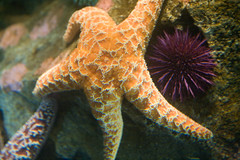1. True or False: Sea stars are fish.
2. True or False: Sea stars are closely related to sea cucumbers, sea urchins and brittle stars.
3. True or False: Sea stars have a flexible skeleton.
4. True or False: Sea stars breathe through gills.
5. True or False: Sea stars can regenerate most body parts.
(Answers can be found here.)
Have a question for the Beach Chair Scientist? E-mail info@beachchairscientist.com.









What people are saying …